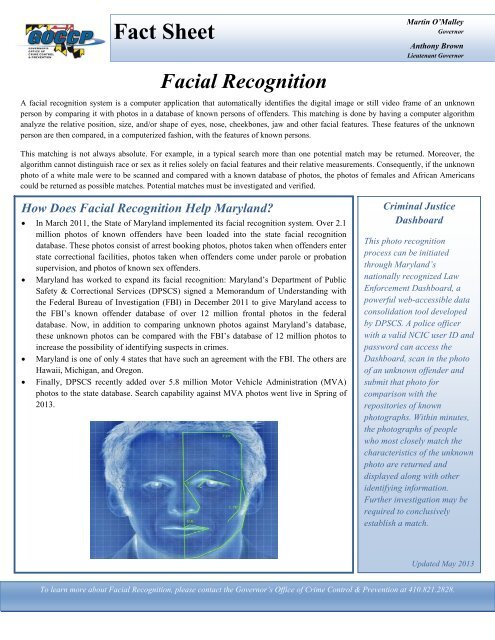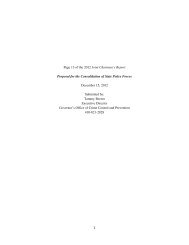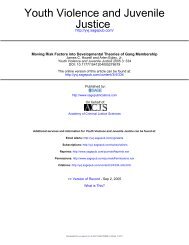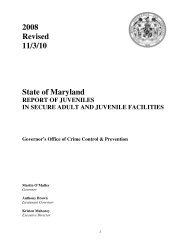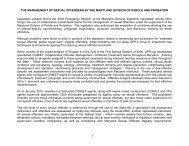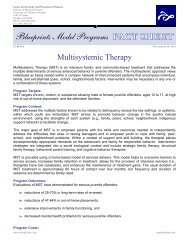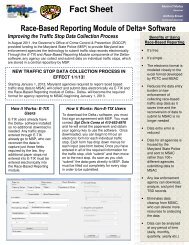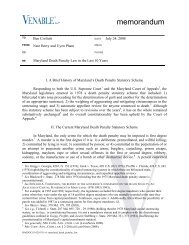Facial Recognition - Governor's Office of Crime Control & Prevention ...
Facial Recognition - Governor's Office of Crime Control & Prevention ...
Facial Recognition - Governor's Office of Crime Control & Prevention ...
You also want an ePaper? Increase the reach of your titles
YUMPU automatically turns print PDFs into web optimized ePapers that Google loves.
Fact Sheet<br />
<strong>Facial</strong> <strong>Recognition</strong><br />
Martin O’Malley<br />
Governor<br />
Anthony Brown<br />
Lieutenant Governor<br />
A facial recognition system is a computer application that automatically identifies the digital image or still video frame <strong>of</strong> an unknown<br />
person by comparing it with photos in a database <strong>of</strong> known persons <strong>of</strong> <strong>of</strong>fenders. This matching is done by having a computer algorithm<br />
analyze the relative position, size, and/or shape <strong>of</strong> eyes, nose, cheekbones, jaw and other facial features. These features <strong>of</strong> the unknown<br />
person are then compared, in a computerized fashion, with the features <strong>of</strong> known persons.<br />
This matching is not always absolute. For example, in a typical search more than one potential match may be returned. Moreover, the<br />
algorithm cannot distinguish race or sex as it relies solely on facial features and their relative measurements. Consequently, if the unknown<br />
photo <strong>of</strong> a white male were to be scanned and compared with a known database <strong>of</strong> photos, the photos <strong>of</strong> females and African Americans<br />
could be returned as possible matches. Potential matches must be investigated and verified.<br />
How Does <strong>Facial</strong> <strong>Recognition</strong> Help Maryland?<br />
In March 2011, the State <strong>of</strong> Maryland implemented its facial recognition system. Over 2.1<br />
million photos <strong>of</strong> known <strong>of</strong>fenders have been loaded into the state facial recognition<br />
database. These photos consist <strong>of</strong> arrest booking photos, photos taken when <strong>of</strong>fenders enter<br />
state correctional facilities, photos taken when <strong>of</strong>fenders come under parole or probation<br />
supervision, and photos <strong>of</strong> known sex <strong>of</strong>fenders.<br />
Maryland has worked to expand its facial recognition: Maryland’s Department <strong>of</strong> Public<br />
Safety & Correctional Services (DPSCS) signed a Memorandum <strong>of</strong> Understanding with<br />
the Federal Bureau <strong>of</strong> Investigation (FBI) in December 2011 to give Maryland access to<br />
the FBI’s known <strong>of</strong>fender database <strong>of</strong> over 12 million frontal photos in the federal<br />
database. Now, in addition to comparing unknown photos against Maryland’s database,<br />
these unknown photos can be compared with the FBI’s database <strong>of</strong> 12 million photos to<br />
increase the possibility <strong>of</strong> identifying suspects in crimes.<br />
Maryland is one <strong>of</strong> only 4 states that have such an agreement with the FBI. The others are<br />
Hawaii, Michigan, and Oregon.<br />
Finally, DPSCS recently added over 5.8 million Motor Vehicle Administration (MVA)<br />
photos to the state database. Search capability against MVA photos went live in Spring <strong>of</strong><br />
2013.<br />
Criminal Justice<br />
Dashboard<br />
This photo recognition<br />
process can be initiated<br />
through Maryland’s<br />
nationally recognized Law<br />
Enforcement Dashboard, a<br />
powerful web-accessible data<br />
consolidation tool developed<br />
by DPSCS. A police <strong>of</strong>ficer<br />
with a valid NCIC user ID and<br />
password can access the<br />
Dashboard, scan in the photo<br />
<strong>of</strong> an unknown <strong>of</strong>fender and<br />
submit that photo for<br />
comparison with the<br />
repositories <strong>of</strong> known<br />
photographs. Within minutes,<br />
the photographs <strong>of</strong> people<br />
who most closely match the<br />
characteristics <strong>of</strong> the unknown<br />
photo are returned and<br />
displayed along with other<br />
identifying information.<br />
Further investigation may be<br />
required to conclusively<br />
establish a match.<br />
Updated May 2013<br />
To learn more about <strong>Facial</strong> <strong>Recognition</strong>, please contact the Governor’s <strong>Office</strong> <strong>of</strong> <strong>Crime</strong> <strong>Control</strong> & <strong>Prevention</strong> at 410.821.2828.
Fact Sheet<br />
Martin O’Malley<br />
Governor<br />
Anthony Brown<br />
Lieutenant Governor<br />
How Is <strong>Facial</strong> <strong>Recognition</strong> Used?<br />
Maryland worked with DataWorks, a nationwide provider <strong>of</strong> law enforcement and criminal justice technology,<br />
to develop facial recognition capability.<br />
<strong>Facial</strong> recognition is a power force-multiplier that law enforcement can use to identify surveillance photos <strong>of</strong><br />
unknown people, to identify suspects whose images have been recorded by security cameras and to even<br />
identify unknown photos posted on social media sites such as Facebook. It is even possible to identify an artist’s<br />
sketch <strong>of</strong> a suspect by using facial recognition.<br />
<strong>Facial</strong> <strong>Recognition</strong> Example:<br />
A law enforcement agency in<br />
Maryland was investigating a<br />
shooting. A witness identified a<br />
photograph posted on a social media<br />
site as the photo <strong>of</strong> the suspect. This<br />
social media photo was scanned in<br />
and compared with known photo<br />
databases to develop a lead for the<br />
police.<br />
To learn more about <strong>Facial</strong> <strong>Recognition</strong>, please contact the Governor’s <strong>Office</strong> <strong>of</strong> <strong>Crime</strong> <strong>Control</strong> & <strong>Prevention</strong> at 410.821.2828.


